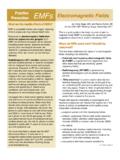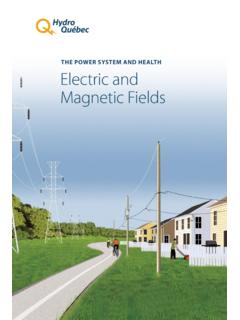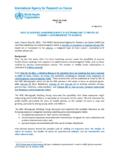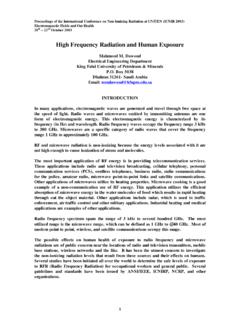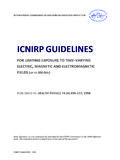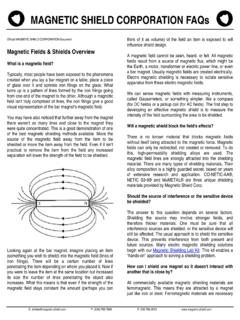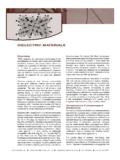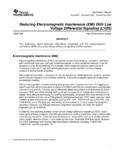Transcription of HIGH VOLTAGE PROPERTIES OF INSULATING …
1 high VOLTAGE PROPERTIES OF INSULATING MATERIALS measured IN THE ULTRA WIDEBAND Mayes , Mayes, Lara, Applied Physical Electronics, , Austin TX Altgilbers Space and Missile Defense Command, Huntsville AL * Distribution A, 5147-06 Abstract Numerous dielectrics have been developed for various high - VOLTAGE high -power microwave applications. The primary goals for HPM insulation are to provide adequate insulation over the lifetime of the device, provide high dielectric strength at low volume and weight, and function with minimal maintenance and ancillary components.
2 Current testing methods for dielectric materials are antiquated processes developed around the 60 Hz machine world and prove inadequate for high - VOLTAGE high - frequencies pulses. We report the development of an insulation processing and testing system for engineering and verifying solid and resin/epoxy dielectric insulators for high - VOLTAGE radar systems in the pulse regime. The system tests material PROPERTIES at high voltages over a frequency range of 100 MHz to 10 GHz. A second procedure characterizes breakdown and partial discharge thresholds. The system targets in-situ inspection of the dielectric liner within an HPM generator housing to verify insulator integrity prior to deployment.
3 I. INTRODUCTION Current and future HPM systems rely on advancements in dielectric materials due to continued increase of HV in smaller volumes. Performance characteristics in dielectric strength and thermal conductivity are important for mobile or airborne systems, since higher dielectric strengths lead to smaller containment vessels and increased thermal conductivity reduces heat removal requirements. high frequency radiation sources, such as x-band radar systems, typically exhibit extremely compact geometries that result in high electric field strengths between com-ponents and ground planes.
4 Inadequate characterization of INSULATING materials reduces the range of VOLTAGE levels to operation at known safe levels, because operating margins in overstressed conditions are not well docu-mented. Currently, safe operating parameters are determined using testing procedures employed by the power industry for many decades Development of HPM technologies for mobile terrestrial and airborne systems is well underway. Such systems may operate with source voltages of several hun-dred kV. Typically, these HV sources use electronegative gases or liquids as INSULATING mediums, and include transformer oil, Flourinert, and sulfur-hexaflouride (SF6).
5 These media are plagued with a high overhead in filtering and flowing systems, but offer the advantage of self-healing insulation. Systems employing solid dielectrics may result in reduced volumes and higher operating voltages, but are vulnerable to catastrophic failure due to the lack of understanding of their physical PROPERTIES at operating points in applied VOLTAGE and frequency for short pulses. Thus, the gains in operating parameters are nominal since safety margins are chosen very conservatively. We present results of a research effort designed to incorporate engineered solid dielectric materials into RF and HPM system design with a higher degree of confidence of the material meeting electrical and thermal performance specifications.
6 The initial phase of the effort concentrated on establishing testing procedures for existing materials, with measurement of dielectric constant, loss, partial discharge and breakdown VOLTAGE , and dielectric strength. We have tested a variety of materials with ultra wideband (UWB) frequencies (100 MHz to more than 2 GHz) and extreme VOLTAGE levels in excess of 200 kV in the pulse regime and report the results in this letter. Future efforts will apply this methodology and the information gleaned to compliment the design of customized materials in HV systems.
7 material processing techniques and post-process test design are in current development at APELC to identify material weaknesses, partial discharge and structural flaws, in order to ensure insulator viability prior to deployment II. BACKGROUND In this section we give background information and the analysis equations used in the characterization of the dielectric materials identified in Table 1. These materials were selected because of their use as microwave insulators. The primary goal of first phase of this effort is to experimentally characterize dielectric PROPERTIES and quantify differences with vendor specifications.
8 Two geometries were constructed for the tests. One was a standard stripline on dielectric substrate; the second was a hockey puck configuration with two electrodes embedded in the dielectric substrate to form a parallel plate geometry with a gap spacing of inch. A. Calculation of Relative Permittivity Permittivity was measured using the stripline geometry. The relative permittivity is calculated from standard transmission line theory. Stripline impedance is related to reflection coefficient 1 ohm1 LoZZ+ = . (1) The relation between the impedance of a stripline trans-mission line is and the relative permittivity r is given by ()377 ohm/2 LrZwh =+ (2)where w is the strip width, h is the height above the ground plane, and it is assumed that w>h [2].
9 Equation (2) was used to fabricate striplines of 50 using the vendor specified value for r at 1 MHz. The frequency dependence of the relative permittivity may be determined with scattering parameter s11 []111113771501( / ) 2rsswh = ++ (3) where ()11sf is determined by a frequency sweep in the experiment. B. Calculation of propagation delay Time delay is defined as the difference between the pulse propagation time through cable and the pulse propagation time through the stripline and cable combin-ation. The time delay is given by secpropLv = (4) where L is the length of the stripline and propv is the propagation speed.
10 The propagation speed through the stripline in the absence of dielectric substrate is a known quantity c. Hence, by rrpropcnv == (5) we may calculate refractive index n thence the relative permittivity, since 1r = for a nonmagnetic material [2]. C. Calculation of dissipation and loss The dissipation factor D is defined in terms of the loss tangent ()tanD = (6) where for permittivity ()()ReImj = , is given by Im()Re() = (7) after [2].

